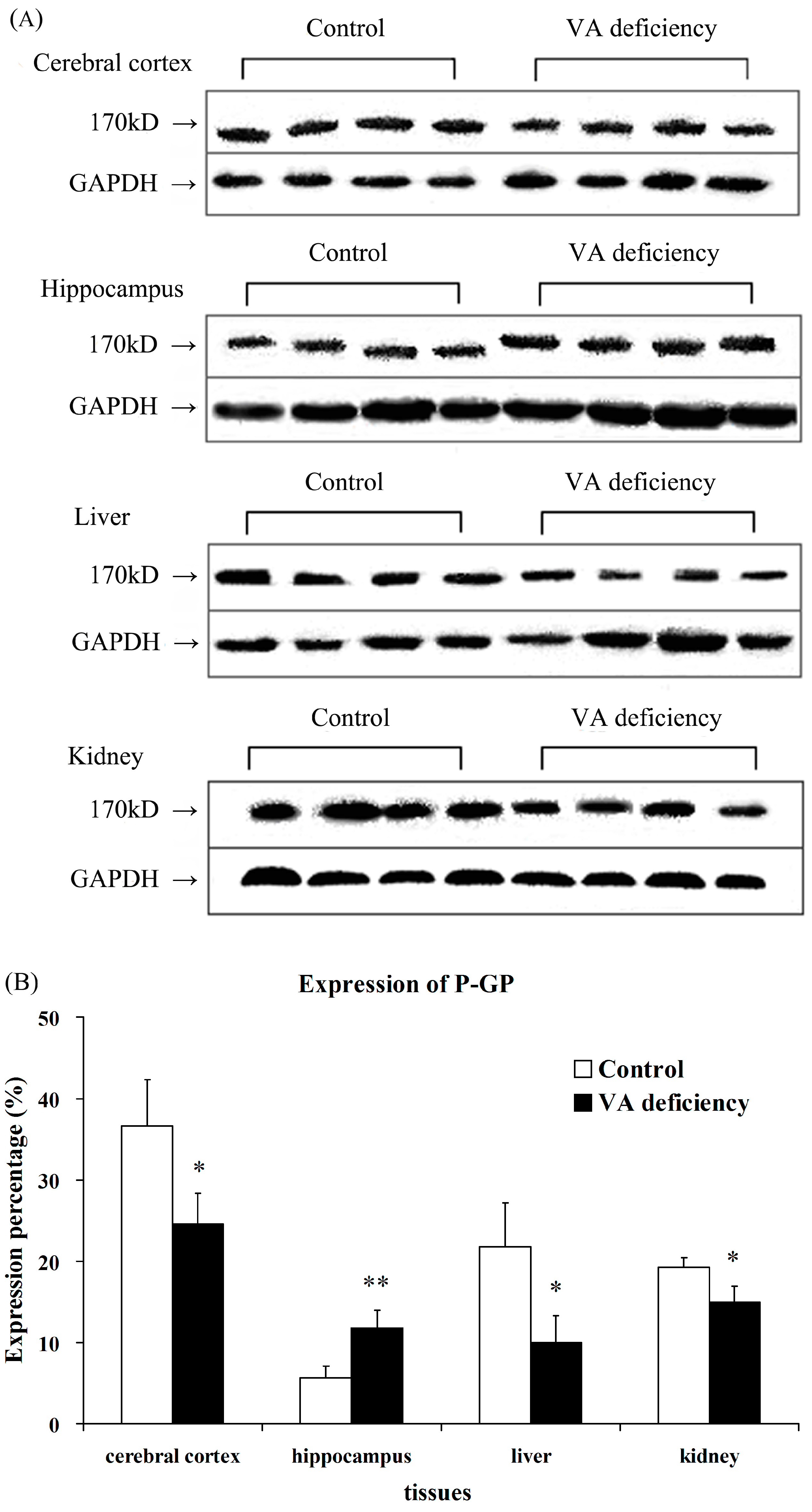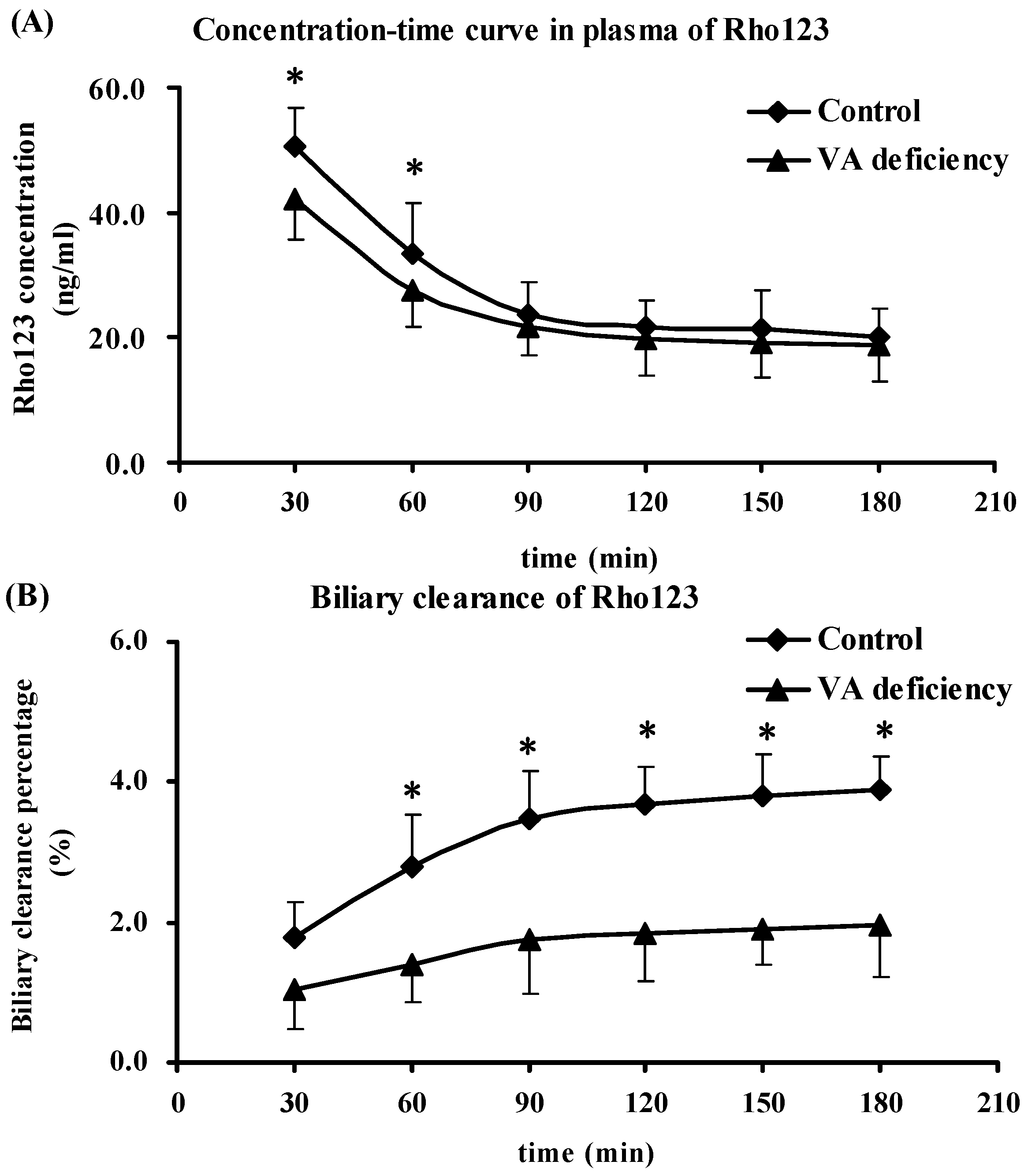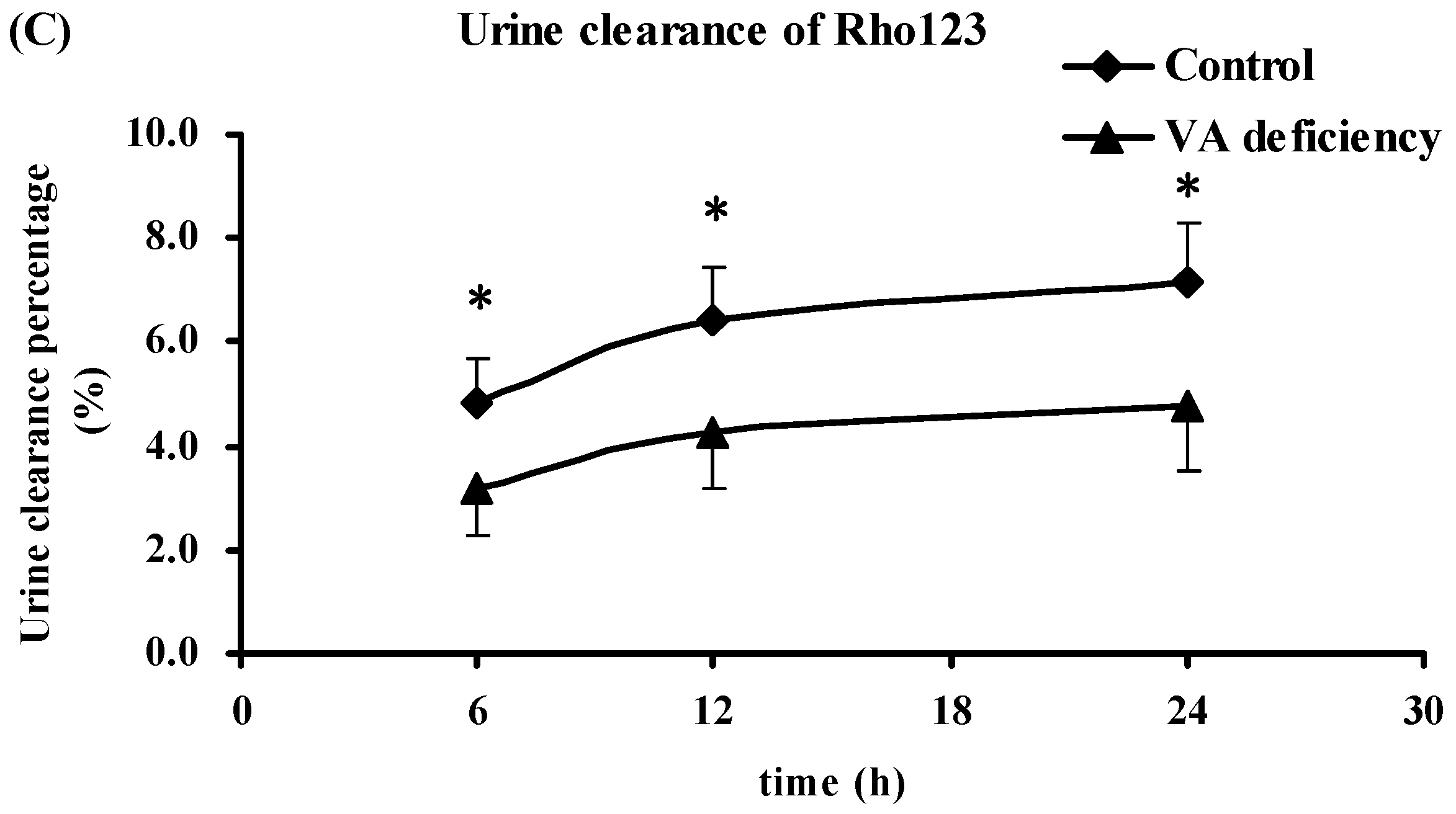The Alterations in the Expression and Function of P-Glycoprotein in Vitamin A-Deficient Rats as well as the Effect of Drug Disposition in Vivo
Abstract
:1. Introduction
2. Results and Discussion
2.1. Physiological and Biochemical Parameters of Experimental Rats
| Parameters | Control | Vitamin A Deficiency |
|---|---|---|
| Body weight (g) | 504 ± 23 | 486 ± 38 |
| Total food intake (g) | 2274 ± 216 | 1999 ± 270 ** |
| Vitamin A level in liver (µg/g) | 10.6 ± 1.4 | 2.4 ± 0.8 ** |
| Vitamin A level in serum (µg/mL) | 13.5 ± 2.3 | 3.1 ± 0.7 ** |
2.2. Level of Abcb1 mRNA

2.3. Expression of P-GP Protein
2.4. Tissue Distribution of Rho123

| Parameters | Control | Vitamin A Deficiency |
|---|---|---|
| Plasma (ng·mL−1) | 42.74 ± 3.51 | 35.64 ± 1.78 * |
| Cerebral cortex (ng·g−1) | 3.71 ± 0.14 | 8.35 ± 0.97 * |
| Kp (cerebral cortex, mL·g−1) | 0.09 ± 0.04 | 0.23 ± 0.07 * |
| Hippocampus (ng·g−1) | 4.37 ± 0.86 | 5.17 ± 1.79 |
| Kp (hippocampus, mL·g−1) | 0.10 ± 0.03 | 0.14 ± 0.05 |
| Liver (ng·g−1) | 49.40 ± 13.42 | 72.06 ± 17.31 * |
| Kp (liver, mL·g−1) | 1.16 ± 0.26 | 2.02 ± 0.71 * |
| Kidney (ng·g−1) | 1065.08 ± 259.67 | 1268.43 ± 314.57 |
| Kp (kidney, mL·g−1) | 24.92 ± 6.46 | 35.59 ± 9.74 * |
2.5. Biliary Excretion and Urinary Excretion of Rho123


2.6. Tissue Distribution of Vincristine
| Parameters | Control | Vitamin A Deficiency |
|---|---|---|
| Plasma (ng·mL−1) | 39.47 ± 9.51 | 30.41 ± 4.78 * |
| Cerebral cortex (ng·g−1) | 13.02 ± 3.38 | 34.97 ± 5.97 * |
| Kp (cerebral cortex, mL·g−1) | 0.33 ± 0.67 | 1.15 ± 0.32 * |
| Hippocampus (ng·g−1) | 10.65 ± 3.99 | 15.51 ± 4.06 * |
| Kp (hippocampus, mL·g−1) | 0.27 ± 0.43 | 0.51 ± 0.37 * |
| Liver (ng·g−1) | 574.68 ± 38.42 | 950.92 ± 35.25 ** |
| Kp (liver, mL·g−1) | 14.56 ± 3.51 | 31.27 ± 6.21 ** |
| Kidney (ng·g−1) | 1640.37 ± 59.67 | 1714.82 ± 41.57 * |
| Kp (kidney, mL·g−1) | 41.56 ± 4.64 | 56.59 ± 3.31 ** |
3. Materials and Methods
3.1. Animals
3.2. Vitamin A Deficiency Model
| Composition | Control Diet | Vitamin A-Free Diet |
|---|---|---|
| Casein | 20% | 20% |
| Gelatinized-starch | 44.5% | 44.5% |
| Sucrose | 22% | 22% |
| Corn oil | 5% | 5% |
| Cellulose | 2% | 2% |
| Mineral mixture | 5% | 5% |
| Vitamin mixture | 1% | — |
| Vitamin A-free vitamin mixture | — | 1% |
| methionine | 0.3% | 0.3% |
| Choline bitartrate | 0.2% | 0.2% |
3.3. qRT-PCR Analysis
| Gene | GeneBank | Amplicon (bp) | Sequence Forward | Sequence Reverse |
|---|---|---|---|---|
| Abcb1a | AF257746 | 351 | 5′-GCCCTGTTCTTGGACTGT-3′ | 5′-GGCCGTGATAGCTTTCTT-3′ |
| Abcb1b | AY082609 | 351 | 5′-GCCCATCCTGTTTGACTG-3′ | 5′-CGCTTCCTGGACGACCTT-3′ |
| β-actin | NM_007393.3 | 365 | 5′-TGACGTGGACATCCGCAAAG-3′ | 5′-CTGGAAGGTGGACAGCGAGG-3′ |
3.4. Western Blot Assay
3.5. Tissue Distribution of Rho123
3.6. Biliary Excretion and Urinary Excretion of Rho123
3.7. Tissue Distribution of Vincristine
3.8. Sample Assay
3.9. Data Analysis
3.10. Materials
4. Conclusions
Acknowledgments
Author Contributions
Conflicts of Interest
References
- Bray, B.J.; Goodin, M.G.; Inder, R.E.; Rosengren, R.J. The effect of retinol on hepatic and renal drug-metabolising enzymes. Food Chem. Toxicol. 2001, 39, 1–9. [Google Scholar] [CrossRef]
- Chen, S.; Wang, K.; Yvonne-Wan, Y.J. Retinoids activate RXR/CAR-mediated pathway and induce CYP3A. Biochem. Pharmacol. 2010, 79, 270–276. [Google Scholar] [CrossRef] [PubMed]
- Wang, K.; Chen, S.; Xie, W.; Yvonne-Wan, Y.J. Retinoids induce cytochrome P450 3A4 through RXR/VDR-mediated pathway. Biochem. Pharmacol. 2008, 75, 2204–2213. [Google Scholar] [CrossRef] [PubMed]
- Schinkel, A.H.; Jonker, J.W. Mammalian drug efflux transporters of the ATP binding cassette (ABC) family: An overview. Adv. Drug Deliv. Rev. 2003, 55, 3–29. [Google Scholar] [CrossRef]
- Marchetti, S.; Mazzanti, R.; Beijnen, J.H.; Schellens, J.H. Concise review: Clinical relevance of drug drug and herb drug interactions mediated by the ABC transporter ABCB1 (MDR1, P-glycoprotein). Oncologist 2007, 12, 927–941. [Google Scholar] [CrossRef] [PubMed]
- Nishio, N.; Katsura, T.; Ashida, K.; Okuda, M.; Inui, K. Modulation of P-glycoprotein expression in hyperthyroid rat tissues. Drug Metab. Dispos. 2005, 33, 1584–1587. [Google Scholar] [CrossRef] [PubMed]
- Brady, J.M.; Cherrington, N.J.; Hartley, D.P.; Buist, S.C.; Li, N.; Klaassen, C.D. Tissue distribution and chemical induction of multiple drug resistance genes in rats. Drug Metab. Dispos. 2002, 30, 838–844. [Google Scholar] [CrossRef] [PubMed]
- Dey, S.; Patel, J.; Anand, B.S.; Jain-Vakkalagadda, B.; Kaliki, P.; Pal, D.; Mitra, A.K. Molecular evidence and functional expression of P-glycoprotein (MDR1) in human and rabbit cornea and corneal epithelial cell lines. Investig. Ophthalmol. Vis. Sci. 2003, 44, 2909–2918. [Google Scholar] [CrossRef]
- Fromm, M.F. Importance of P-glycoprotein at blood–tissue barriers. Trends Pharmacol. Sci. 2004, 25, 423–429. [Google Scholar] [CrossRef] [PubMed]
- Lickeig, A.J.; Fisher, C.D.; Augustine, L.M.; Aleksunes, L.M.; Besselsen, D.G.; Slitt, A.L.; Manautou, J.E.; Cherrington, N.J. Efflux transporter expression and acetaminophen metabolite excretion are altered in rodent models of nonalcoholic fatty liver disease. Drug Metab. Dispos. 2007, 35, 1970–1978. [Google Scholar] [CrossRef] [PubMed]
- Naud, J.; Michaud, J.; Boisvert, C.; Desbiens, K.; Leblond, F.A.; Mitchell, A.; Jones, C.; Bonnardeaux, A.; Pichette, V. Down-regulation of intestinal drug transporters in chronic renal failure in rats. J. Pharmacol. Exp. Ther. 2007, 320, 978–985. [Google Scholar] [CrossRef] [PubMed]
- Tada, Y.; Wada, M.; Kuroiwa, K.; Kinugawa, N.; Harada, T.; Nagayama, J.; Nakagawa, M.; Naito, S.; Kuwano, M. MDR1 gene overexpression and altered degree of methylation at the promoter region in bladder cancer during chemotherapeutic treatment. Clin. Cancer Res. 2000, 6, 4618–4627. [Google Scholar] [PubMed]
- Zhang, L.L.; Lu, L.; Jin, S.; Jing, X.Y.; Yao, D.; Hu, N.; Liu, L.; Duan, R.; Liu, X.; Wang, G.; et al. Tissue-specific alterations in expression and function of P-glycoprotein in streptozotocin-induced diabetic rats. Acta Pharmacol. Sin. 2011, 32, 956–966. [Google Scholar] [CrossRef] [PubMed]
- Handschin, C.; Meyer, U.A. Induction of drug metabolism: The role of nuclear receptors. Pharmacol. Rev. 2003, 55, 649–673. [Google Scholar] [CrossRef] [PubMed]
- Chen, Y.; Tang, Y.; Guo, C.; Wang, J.; Boral, D.; Nie, D. Nuclear receptors in the multidrug resistance through the regulation of drug-metabolizing enzymes and drug transporters. Biochem. Pharmacol. 2012, 83, 1112–1126. [Google Scholar] [CrossRef] [PubMed]
- Chen, W.; Chen, G. The Roles of Vitamin A in the Regulation of Carbohydrate, Lipid, and Protein Metabolism. J. Clin. Med. 2014, 3, 453–479. [Google Scholar] [CrossRef] [PubMed]
- Olivares, A.; Rey, A.I.; Daza, A.; López-Bote, C.J. Low levels of dietary vitamin A increase intramuscular fat content and polyunsaturated fatty acid proportion in liver from lean pigs. Livest. Sci. 2011, 137, 31–36. [Google Scholar] [CrossRef]
- Nakamoto, A.; Shuto, E.; Tsutsumi, R.; Nakamoto, M.; NII, Y.; Sakai, T. Vitamin A deficiency inpairs induction of oral tolerance in mice. J. Nutr. Sci. Vitaminol. 2015, 61, 147–153. [Google Scholar] [CrossRef] [PubMed]
- Liu, W.; Saint, D.A. Validation of a quantitative method for real time PCR kinetics. Biochem. Biophys. Res. Commun. 2002, 294, 347–353. [Google Scholar] [CrossRef]
- Jing, X.; Liu, X.; Wen, T.; Xie, S.; Yao, D.; Liu, X.; Wang, G.; Xie, L. Combined effects of epileptic seizure and phenobarbital induced overexpression of P-glycoprotein in brain of chemically kindled rats. Br. J. Pharmacol. 2010, 159, 1511–1522. [Google Scholar] [CrossRef] [PubMed]
- Yu, S.; Yu, Y.; Liu, L.; Wang, X.; Lu, S.; Liang, Y.; Xie, L.; Wang, G. Increased plasma exposures of five protoberberine alkaloids from Coptidis Rhizoma in streptozotocin-induced diabetic rats: Is P-GP involved? Planta Med. 2010, 76, 876–881. [Google Scholar] [CrossRef] [PubMed]
- Zhang, L.; Gai, Q.H.; Zu, Y.G.; Yang, L.; Ma, Y.L.; Liu, Y. Simultaneous quantitative determination of five alkaloids in Catharanthus roseus by HPLC-ESI-MS/MS. Chin. J. Nat. Med. 2014, 12, 786–793. [Google Scholar] [CrossRef]
- Guo, P.; Wang, X.; Zhou, F.; Gallo, J.M. Determination of vincristine in mouse plasma and brain tissues by liquid chromatography-electrospray mass spectrometry. J. Chromatogr. B Anal. Technol. Biomed. Life Sci. 2004, 809, 273–278. [Google Scholar] [CrossRef]
- Van Belle, S.J.P.; Smet, M.D.; Neve, W.D.; Monsaert, C.; Storme, G.A.; Massart, D.L. Determination of Vinca Alkaloids in mouse tissues by high-performance liquid chromatography. J. Chromatogr. B 1992, 578, 223–229. [Google Scholar] [CrossRef]
- Schinkel, A.H.; Smit, J.J.; van Tellingen, O.; Beijnen, J.H.; Wagenaar, E.; van Deemter, L.; Mol, C.A.; van der Valk, M.A.; Robanus-Maandag, E.C.; te Riele, H.P.; et al. Disruption of the mouse mdr1a P-glycoprotein gene leads to a deficiency in the blood-brain barrier and to increased sensitivity to drugs. Cell 1994, 77, 491–502. [Google Scholar] [CrossRef]
- Borst, P.; Schinkel, A.H. P-glycoprotein ABCB1, a major player in drug handling by mammals. J. Clin. Investig. 2013, 123, 4131–4133. [Google Scholar] [CrossRef] [PubMed]
- Bond, T.D.; Valverde, M.A.; Higgins, C.F. Protein kinase C phosphorylation disengages human and mouse-1a P-glycoproteins from influencing the rate of activation of swelling-activated chloride currents. J. Physiol. 1998, 508, 333–340. [Google Scholar] [CrossRef] [PubMed]
- Lecureur, V.; Thottassery, J.V.; Sun, D.; Schuetz, E.G.; Lahti, J.; Zambetti, G.P.; Schuetz, J.D. Mdr1b facilitates p53-mediated cell death and p53 is required for Mdr1b upregulation in vivo. Oncogene 2001, 20, 303–313. [Google Scholar] [CrossRef] [PubMed]
- Zhou, G.; Kuo, M.T. Wild-type p53-mediated induction of rat mdr1b expression by the anticancer drug daunorubicin. J. Biol. Chem. 1998, 273, 15387–15394. [Google Scholar] [CrossRef] [PubMed]
- Ziemann, C.; Bürkle, A.; Kahl, G.F.; Hirsch-Ernst, K.I. Reactive oxygen species participate in mdr1b mRNA and P-glycoprotein overexpression in primary rat hepatocyte cultures. Carcinogenesis 1999, 20, 407–414. [Google Scholar] [CrossRef] [PubMed]
- Barta, C.A.; Sachs-Barrable, K.; Feng, F.; Wasan, K.M. Effects of monoglycerides on P-glycoprotein: Modulation of the activity and expression in Caco-2 cell monolayers. Mol. Pharmacol. 2008, 5, 863–875. [Google Scholar] [CrossRef] [PubMed]
- Nishimura, A.; Honda, N.; Sugioka, N.; Takada, K.; Shibata, N. Evaluation of carbamazepine pharmacokinetic profiles in mice with kainic acid-induced acute seizures. Biol. Pharm. Bull. 2008, 31, 2302–2308. [Google Scholar] [CrossRef] [PubMed]
- Pires, M.M.; Emmert, D.; Hrycyna, C.A.; Chmielewski, J. Inhibition of P-glycoprotein-mediated paclitaxel resistance by reversibly linked quinine homodimers. Mol. Pharmacol. 2009, 75, 92–100. [Google Scholar] [CrossRef] [PubMed]
- Tanaka, S.; Masuda, M.; Nakajima, K.; Ido, N.; Ohtsuka, T.; Nishida, M.; Utsumi, H.; Hirano, T. P-glycoprotein function in peripheral T lymphocyte subsets of myasthenia gravis patients: Clinical implications and influence of glucocorticoid administration. Int. Immunopharmacol. 2009, 9, 284–290. [Google Scholar] [CrossRef] [PubMed]
- Borbás, T.; Benko, B.; Dalmadi, B.; Szabó, I.; Tihanyi, K. Insulin in flavin-containing monooxygenase regulation Flavin-containing monooxygenase and cytochrome P450 activities in experimental diabetes. Eur. J. Pharm. Sci. 2006, 28, 51–58. [Google Scholar] [CrossRef] [PubMed]
- Huber, J.D.; VanGilder, R.L.; Houser, K.A. Streptozotocin-induced diabetes progressively increases blood-brain barrier permeability in specific brain regions in rats. Am. J. Physiol. Heart Circ. Physiol. 2006, 291, 2660–2668. [Google Scholar] [CrossRef] [PubMed]
- Hawkins, B.T.; Davis, T.P. The blood-brain barrier/neurovascular unit in health and disease. Pharmacol. Rev. 2005, 57, 173–185. [Google Scholar] [CrossRef] [PubMed]
- Hawkins, B.T.; Ocheltree, S.M.; Norwood, K.M.; Egleton, R.D. Decreased blood-brain barrier permeability to fluorescein in streptozotocin-treated rats. Neurosci. Lett. 2007, 411, 1–5. [Google Scholar] [CrossRef] [PubMed]
- Liu, H.; Zhang, D.; Xu, X.; Liu, X.; Wang, G.; Xie, L.; Pang, X.; Liu, L. Attenuated function and expression of P-glycoprotein at blood–brain barrier and increased brain distribution of phenobarbital in streptozotocin-induced diabetic mice. Eur. J. Pharmacol. 2007, 561, 226–232. [Google Scholar] [CrossRef] [PubMed]
- Kamei, J.; Hirano, S.; Miyata, S.; Saitoh, A.; Onodera, K. Effects of first-and second-generation histamine-H1-receptor antagonists on the pentobarbital-induced loss of the righting reflex in streptozotocin-induced diabetic mice. J. Pharmacol. Sci. 2005, 97, 266–272. [Google Scholar] [CrossRef] [PubMed]
- Liu, Y.; Liu, H.; Yang, J.; Liu, X.; Lu, S.; Wen, T.; Xie, L.; Wang, G. Increased amyloid beta-peptide (1–40) level in brain of streptozotocin-induced diabetic rats. Neuroscience 2008, 153, 796–802. [Google Scholar] [CrossRef] [PubMed]
- Ueda, K.; Okamura, N.; Hirai, M.; Tanigawara, Y.; Saeki, T.; Kioka, N.; Komano, T.; Hori, R. Human P-glycoprotein transports cortisol, aldosterone, and dexamethasone, but not progesterone. J. Biol. Chem. 1992, 267, 24248–24252. [Google Scholar] [PubMed]
- Miyazawa, T.; Kubo, E.; Takamura, Y.; Akagi, Y. Up-regulation of P-glycoprotein expression by osmotic stress in rat sugar cataract. Exp. Eye Res. 2007, 84, 246–253. [Google Scholar] [CrossRef] [PubMed]
- Sample Availability: Not available.
© 2015 by the authors. Licensee MDPI, Basel, Switzerland. This article is an open access article distributed under the terms and conditions of the Creative Commons by Attribution (CC-BY) license ( http://creativecommons.org/licenses/by/4.0/).
Share and Cite
Wang, Y.; Qin, H.; Zhang, C.; Huan, F.; Yan, T.; Zhang, L. The Alterations in the Expression and Function of P-Glycoprotein in Vitamin A-Deficient Rats as well as the Effect of Drug Disposition in Vivo. Molecules 2016, 21, 46. https://doi.org/10.3390/molecules21010046
Wang Y, Qin H, Zhang C, Huan F, Yan T, Zhang L. The Alterations in the Expression and Function of P-Glycoprotein in Vitamin A-Deficient Rats as well as the Effect of Drug Disposition in Vivo. Molecules. 2016; 21(1):46. https://doi.org/10.3390/molecules21010046
Chicago/Turabian StyleWang, Yubang, Heng Qin, Chengxiang Zhang, Fei Huan, Ting Yan, and Lulu Zhang. 2016. "The Alterations in the Expression and Function of P-Glycoprotein in Vitamin A-Deficient Rats as well as the Effect of Drug Disposition in Vivo" Molecules 21, no. 1: 46. https://doi.org/10.3390/molecules21010046
APA StyleWang, Y., Qin, H., Zhang, C., Huan, F., Yan, T., & Zhang, L. (2016). The Alterations in the Expression and Function of P-Glycoprotein in Vitamin A-Deficient Rats as well as the Effect of Drug Disposition in Vivo. Molecules, 21(1), 46. https://doi.org/10.3390/molecules21010046





